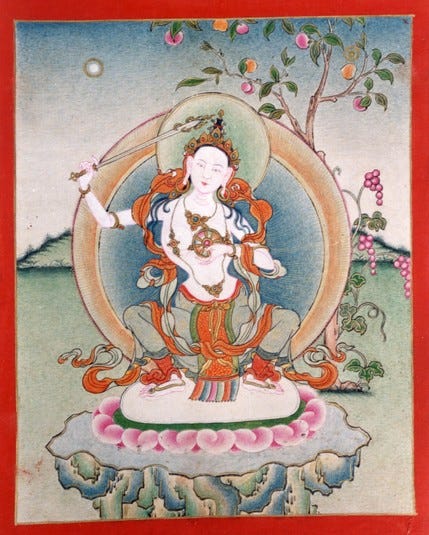རྐང་སྟབས: Feet and legs Postures from Tibetan Buddhist text.
I. ས་གའི་སྟབས (vaiśākhapadaṃ/བཻ་ཤ་ཁ་པཱ་ད): Description: At the width of twenty-six fingers, toes of the legs are facing sideways, and knees are kept straight upright.
Fig.1 Amitāyu
II. ཟླུམ་པོའི་སྟབས (maṇḍalapadaṃ/མཎྜལ་པཱ་ད) Description: Feet in a vaiśākha posture, (legs) in Swan's wings pose.
Fig.2 Pratisarā (སོ་སོར་འབྲང་མ) in maṇḍalapadaṃ
III. སྐྱེས་པའི་རྐང་སྟབས (Jātapadaṃ/ཛཱ་ཏ་པཱ་ད): Description: The left leg (or right leg) straight upright, right (or left) toes facing sideways, right (or left) knee slightly bent, and heels are four inches apart.
Fig. 3. Avalokiteśvara
Fig. 4 Buddha in Jātapadaṃ
IV. མཉམ་པའི་སྟབས་ (samapadaṃ/ས་མ་པཱ་ད): Description: Both feet in parallel position, toes of the both legs facing front, and body upright.
Fig. 5 The Buddha in samapadaṃ
V. རྣམ་པར་གཙིགས་པའི་རྐང་སྟབས (Vikaṭapadaṃ/བི་ཀ་ཊ་པཱ་ད): Description: Place the right foot three handspans in front of the left foot, wherein the right leg is slightly bend at the knee and the left leg is kept complete straight behind its knee.
VI. ཁ་སྦྱོར་གྱི་རྐང་སྟབས (Saṃpuṭapadaṃ/སམྦུ་ཊ་པཱ་ད): Description: The soles of the feeet touching each other.
VII. རུས་སྦལ་གྱི་རྐང་སྟབས་ (Kūrmapadaṃ/ཀུརྨ་པཱ་ད ) Description: The right foot pressing down upon the left upper foot.
VIII. རྐང་གཅིག་གི་རྐང་སྟབས (Ekapadaṃ/ཨེ་ཀ་པཱ་ད): Description: One leg fixed to the ground, and the other leg raised.
Source text:
Tibetan Tengyur text: Marici Sadhana.
Ngorchen Kunga Sangpo (14th-15th century) text: རྡོ་རྗེ་ཕྲེང་བར་གསུངས་པའི་ས་ཡོངས་སུ་གཟུང་བའི་ཆོ་ག་བདུད་ལས་རྣམ་པར་རྒྱལ་བ་བཞུགས་སོ








